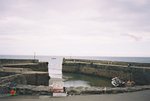Charlestown, Cornwall
|
|
Charlestown_Harbour_cottages_fishermen_St_Austell_Cornwall.jpg
Charlestown (Cornish: Porthmeur) is a working port near St Austell, Cornwall in the far South West of Britain. It was developed in the Georgian era (specifically 1791-1798) as a new town, and named after local landowner Charles Rashleigh who had a hand in its design. It was built to facilitate the export of china clay from the region's quarries and, to a limited extent, still serves that purpose today. In 1790 the settlement was known as West Polmear and had a population of 9 people, this had swelled to 3184 by 1911.
Although Charlestown is approximately 2 miles (3.2km) from St Austell town centre, if you walk between the two you see that they have grown into each other and there is scarcely a break between them. The characters of the two towns are quite different however. Charlestown has remained relatively unchanged, and is very picturesque. The much larger town of St Austell however has a mishmash of architectural styles from the 15th century Holy Trinity Church to 1960s grey concrete structures.
Charlestown is popular with tourists who go to see the unspoiled architecture, paddle in the sea and visit the Charlestown Shipwreck, Rescue and Heritage Centre. The port is used by local fishermen and about three times a month for the export of china clay. The turquoise/blue colour of the sea at Charlestown is due to particles of china clay in the water reflecting the light. Flooded china clay quarries, several of which can be found in the area, are a startling blue/green colour. (Here is an example (http://www.lastrefuge.co.uk/images/html/aerials/UK_aerials/quarry/pages/UK_aerials130.htm), near St Austell)
The harbour and two (pebble) beaches (one on either side of the harbour entrance) are owned by Square Sail, a company who own and sail a fleet of tall ships, one or two of which can often be found at anchor in the harbour, and are frequently open for tours. The best-known tall ship to regularly visit the port was the Maria Asumpta - first launched in 1858 and was the world's oldest working square-rigger. The Maria Asumpta was very popular with tourists and locals alike. In May 1995 she ran aground and broke up on the north Cornish coast, like so many before her, with the loss of three of her sixteen crew.
Charlestown harbour has several times been transformed into historic ports like Bristol for film and television productions. For example, it has starred in Poldark, an adaptation of Jane Austen's Persuasion and films such as The Three Musketeers (1993 version).
External links
- Square Sail (http://www.square-sail.com/) who own the harbour and a fleet of working tall ships
- Photographs of St Paul's parish church (http://freepages.genealogy.rootsweb.com/~cornwallpics/charlestownchurch/), including shots of the interior and stained glass windows
- Information about the Shipwreck, Rescue and Heritage Centre (http://www.cornwall-online.co.uk/restormel/chas-her.htm)
- Three pictures of the Maria Asumpta (http://pplmedia.com/glydisas5.html) (one under full sail, and two of her run aground and sinking in 1995)
- A flooded china clay quarry near St Austell (http://www.lastrefuge.co.uk/images/html/aerials/UK_aerials/quarry/pages/UK_aerials130.htm)
- IMDb (http://www.imdb.com/) pages for productions mentioned:
- Persuasion (http://www.imdb.com/title/tt0114117/) (1995)
- The Three Musketeers (http://www.imdb.com/title/tt0108333/) (1993)
- Poldark (http://www.imdb.com/title/tt0075560/) (1975)



